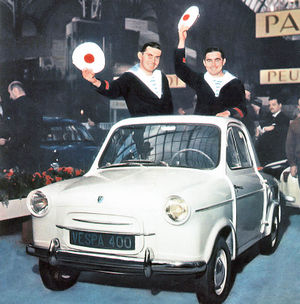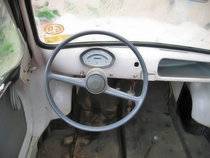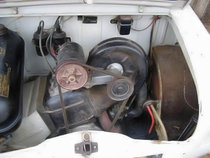Vespa 400
| 250px | |
| Vespa 400 | |
|---|---|
| Manufacturer | ACMA |
| Parent company | Piaggio |
| Production | 1958-1961 |
| Assembly | Fourchambault, France |
| Class | microcar |
| Body style | 2-door coupé Lusso |
| Body style | 2-door Cabrio coach Turismo |
| Layout | RR layout |
| Engine | 393 cc, 2-cylinder, Two-stroke |
| Transmission | 3-speed manual |
| Wheelbase | 1693mm |
| Length | 2850mm |
| Width | 1100mm |
| Weight | 375kg |
| Fuel capacity | 23 l (6 US gal) (5 imp. gal) |
The Vespa 400 is a rear-engined microcar, produced by ACMA (Ateliers de construction de motocycles et d'automobiles) in Fourchambault, France, from 1957 to 1961 to the designs of the Italian Piaggio company. Two different versions were sold, "Lusso" and "Turismo".
The car made its public debut on 26 September 1957 at a press presentation staged in Monaco. The ACMA directors ensured a good attendance from members of the press by also inviting three celebrity racing divers[3] to the Vespa 400 launch.
The 400 was a two seater with room behind the seats to accommodate luggage or two small children on an optional cushion. The front seats were simple tubular metal frames with cloth upholstery on elastic "springs" and between the seats were the handbrake, starter and choke. The gear change was centrally floor mounted. The rear hinged doors were coated on the inside with only a thin plastic lining attached to the metal door panel skin allowing valuable extra internal space. On the early cars the main door windows did not open which attracted criticism, but increased the usable width for the driver and passenger. Instrumentation was very basic with only a speedometer and warning lights for low fuel, main beam, dynamo charging and indicators. The cabriolet fabric roof could be rolled back from the windscreen header rail to the top of the rear engine cover leaving conventional metal sides above the doors. The 12 volt battery was located at the front of the car, behind the dummy front grill, on a shelf that could be slid out. The spare wheel was stowed in a well under the passenger seat.
Specifications
- Layout
- Rear engine, rear wheel drive.
- Engine
- Two cylinder, two stroke, air cooled. Bore, stroke: 63 mm x 63 mm (392 cc).
- Compression ratio
- 6.4 to 1.
Specifications
- Engine
- Two cylinder, two stroke, air cooled. Bore, stroke: 63 mm x 63 mm (393 cc).
- Compression ratio
- 6.4 to 1 with 12 horsepower.
- Suspension
- Four wheel independent. Four double acting hydraulic shock absorbers with coil springs.
- Transmission
- 3 speed, with 2nd, 3rd and reverse synchromesh. 4 speed available in non-U.S. markets.
- Performance
- With only 18 hp (13 kW), top speed is 50 to 55 mph (80 to 90 km/h), depending on road grade, wind conditions, etc. Achieving top speed takes a leisurely 25 seconds. Fuel economy is about 5L/100KM.
External links
- My Vespa 400, Comprehensive French language site


